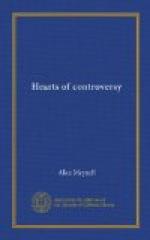* * * * *
Whereas Charlotte Bronte walked, with exultation and enterprise, upon the road of symbols, under the guidance of her own visiting genius, Emily seldom went out upon those far avenues. She was one who practised imagery sparingly. Her style had the key of an inner prose which seems to leave imagery behind in the way of approaches—the apparelled and arrayed approaches and ritual of literature—and so to go further and to be admitted among simple realities and antitypes.
Charlotte Bronte also knew that simple goal, but she loved her imagery. In the passage of Jane Eyre that tells of the return to Thornfield Hall, in ruins by fire, she bespeaks her reader’s romantic attention to an image which in truth is not all golden. She has moments, on the other hand, of pure narrative, whereof each word is such a key as I spoke of but now, and unlocks an inner and an inner plain door of spiritual realities. There is, perhaps, no author who, simply telling what happened, tells it with so great a significance: “Jane, did you hear that nightingale singing in the wood?” and “She made haste to leave us.” But her characteristic calling is to images, those avenues and temples oracular, and to the vision of symbols.
You may hear the poet of great imagery praised as a great mystic. Nevertheless, although a great mystical poet makes images, he does not do so in his greatest moments. He is a great mystic, because he has a full vision of the mystery of realities, not because he has a clear invention of similitudes.
Of many thousand kisses the poor last,
and
Now with his love, now in the colde grave
are lines on the yonder side of imagery. So is this line also:
Sad with the promise of a different sun,
and
Piteous passion keen at having found,
After exceeding ill, a little good.
Shakespeare, Chaucer and Patmore yield us these great examples. Imagery is for the time when, as in these lines, the shock of feeling (which must needs pass, as the heart beats and pauses) is gone by:
Thy heart with dead winged innocence
filled,
Even as a nest with birds,
After the old ones by the hawk are
killed.
I cite these lines of Patmore’s because of their imagery in a poem that without them would be insupportably close to spiritual facts; and because it seems to prove with what a yielding hand at play the poet of realities holds his symbols for a while. A great writer is both a major and a minor mystic, in the self-same poem; now suddenly close to his mystery (which is his greater moment) and anon making it mysterious with imagery (which is the moment of his most beautiful lines).
The student passes delighted through the several courts of poetry, from the outer to the inner, from riches to more imaginative riches, and from decoration to more complex decoration; and prepares himself for the greater opulence of the innermost chamber. But when he crosses the last threshold he finds this mid-most sanctuary to be a hypaethral temple, and in its custody and care a simple earth and a space of sky.




